Tendre fish fillet poached in seasoned water, then topped with spices, Sichuan boiled fish is tasty, pungent and super addictive.
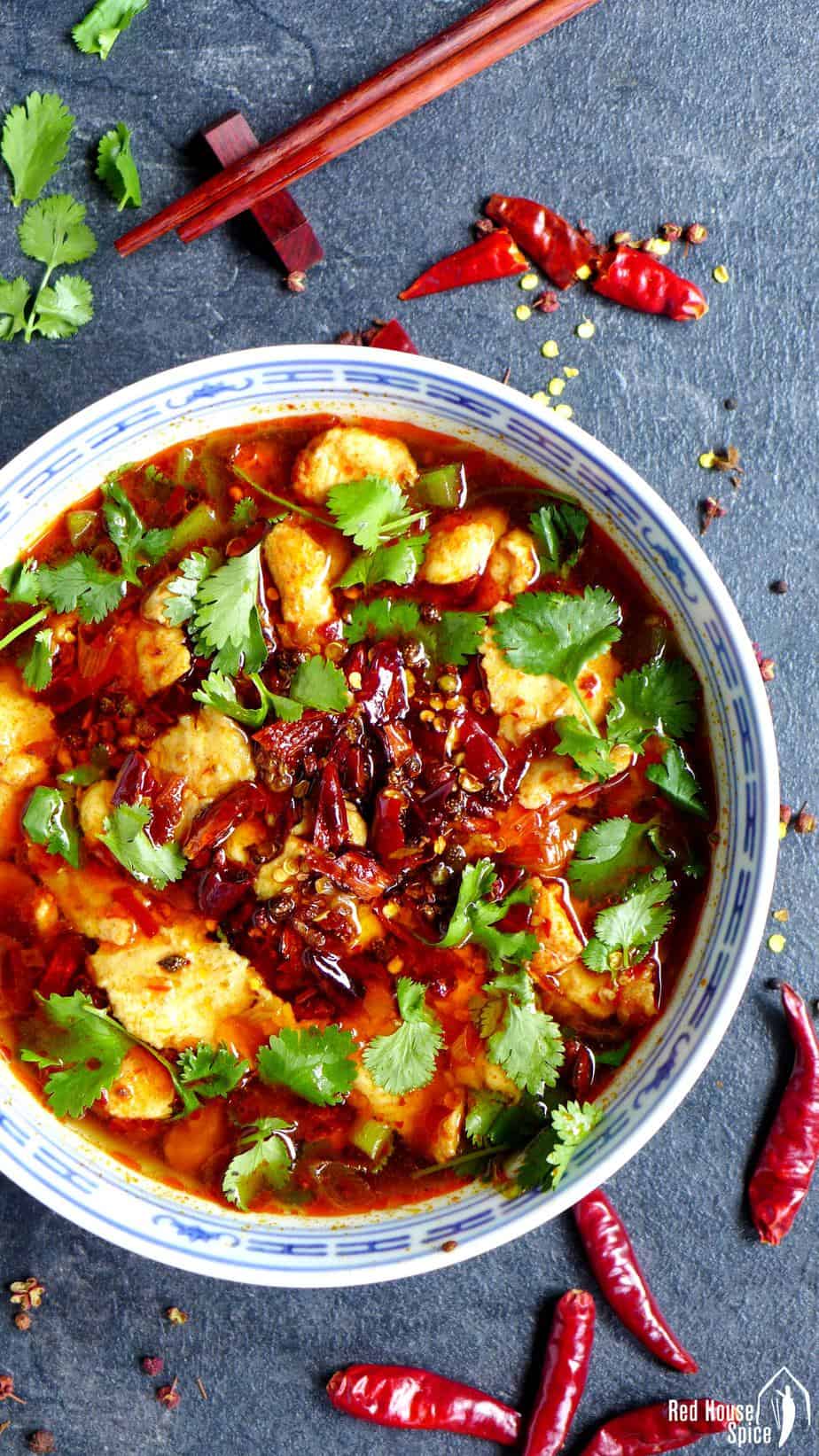
I still remember exactly where I ate Sichuan boiled fish (Shui Zhu Yu, 水煮鱼) for the first time. It was a tiny little restaurant specializing in Sichuan cuisine hidden in a quiet neighbourhood of Beijing. At that moment, I only knew a few famous Sichuan dishes, such as Mapo tofu, Kong Pao chicken, Shredded pork with garlic sauce, etc.. I found Sichuan boiled fish so stunning that later on it became the one dish that I always order whenever it’s on the menu.
It’s tender & succulent
Literally, the Chinese name of Sichuan boil fish “Shui Zhu Yu (水煮鱼)” means water boiled fish. The marinated fish slices are poached briefly in seasoned water. They taste very tender, succulent and packed with flavour.
To achieve the best result, I recommend you use fresh fillets instead of frozen ones. In China, restaurants often have fish tanks from which the customers can choose live fish to be freshly prepared for this dish (Don’t fancy fish, try Sichuan Boiled Beef instead).
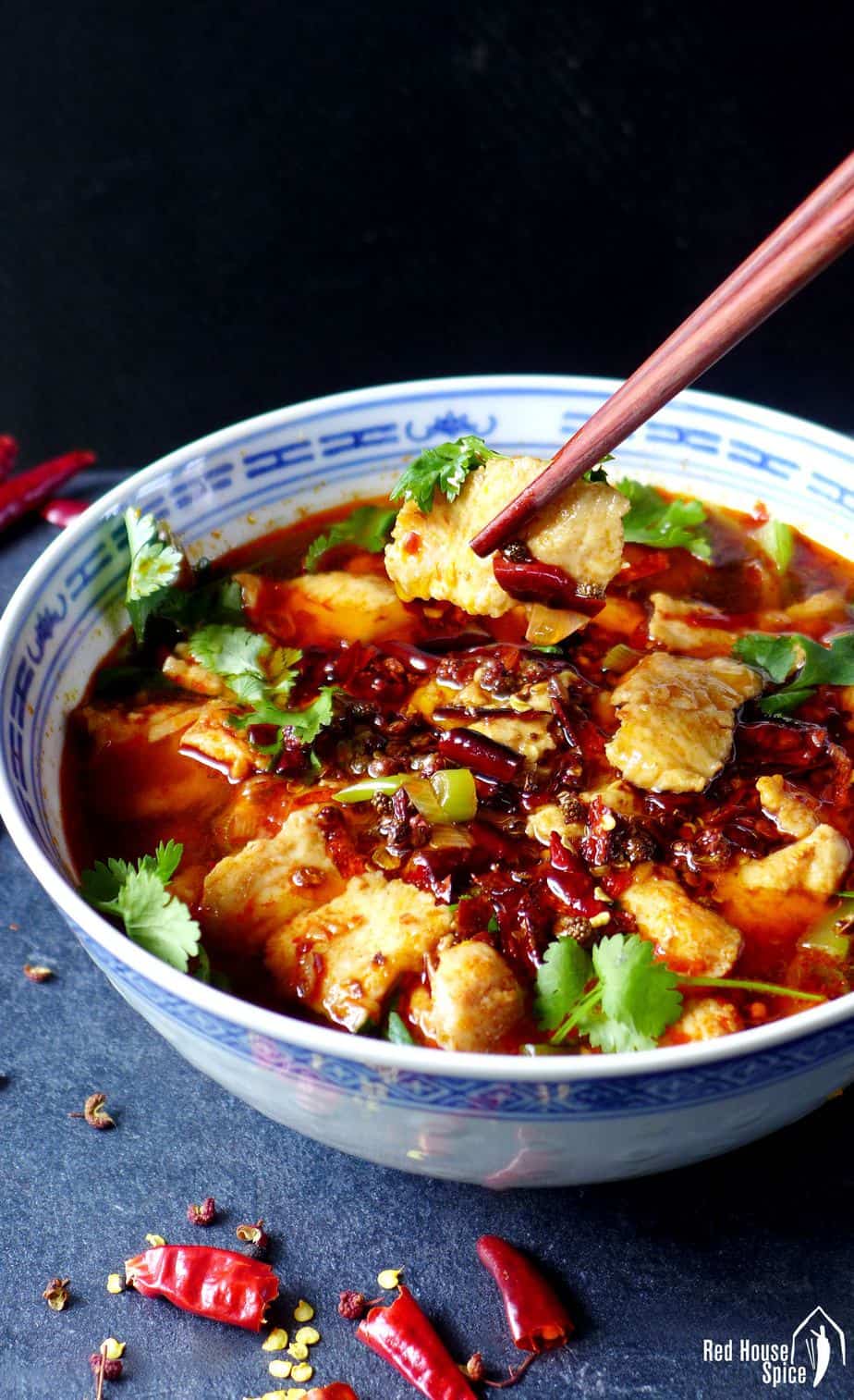
It’s super spicy
As one of the most pungent Chinese dishes, authentic Sichuan boiled fish is famous for its hotness. My friend Junyang adored this dish but unfortunately, she has a low tolerance for spicy food. She used to rinse the fish in a glass of water to reduce the hotness. And little by little she has eventually increased her tolerance.
In my recipe, you can see that the spiciness comes from the generous use of 3 ingredients: dried chilli, Sichuan chilli bean paste and chilli powder.
It gives you a numbing sensation
Sichuan boiled fish is also pungent in another way: it delivers an intensive numbing sensation to your mouth by using quite a lot of Sichuan pepper (it’s an acquired taste but very addictive once you become accustomed to it).
You might have heard or used regular Sichuan pepper (Huajiao, 花椒) which is red in colour. In fact, there is another type of Sichuan pepper called Majiao (麻椒) which has the same shape and size but is green in colour. It’s often used in Sichuan boiled fish to enhance the fragrance. However, you can use regular Sichuan pepper if you can’t find the green ones.
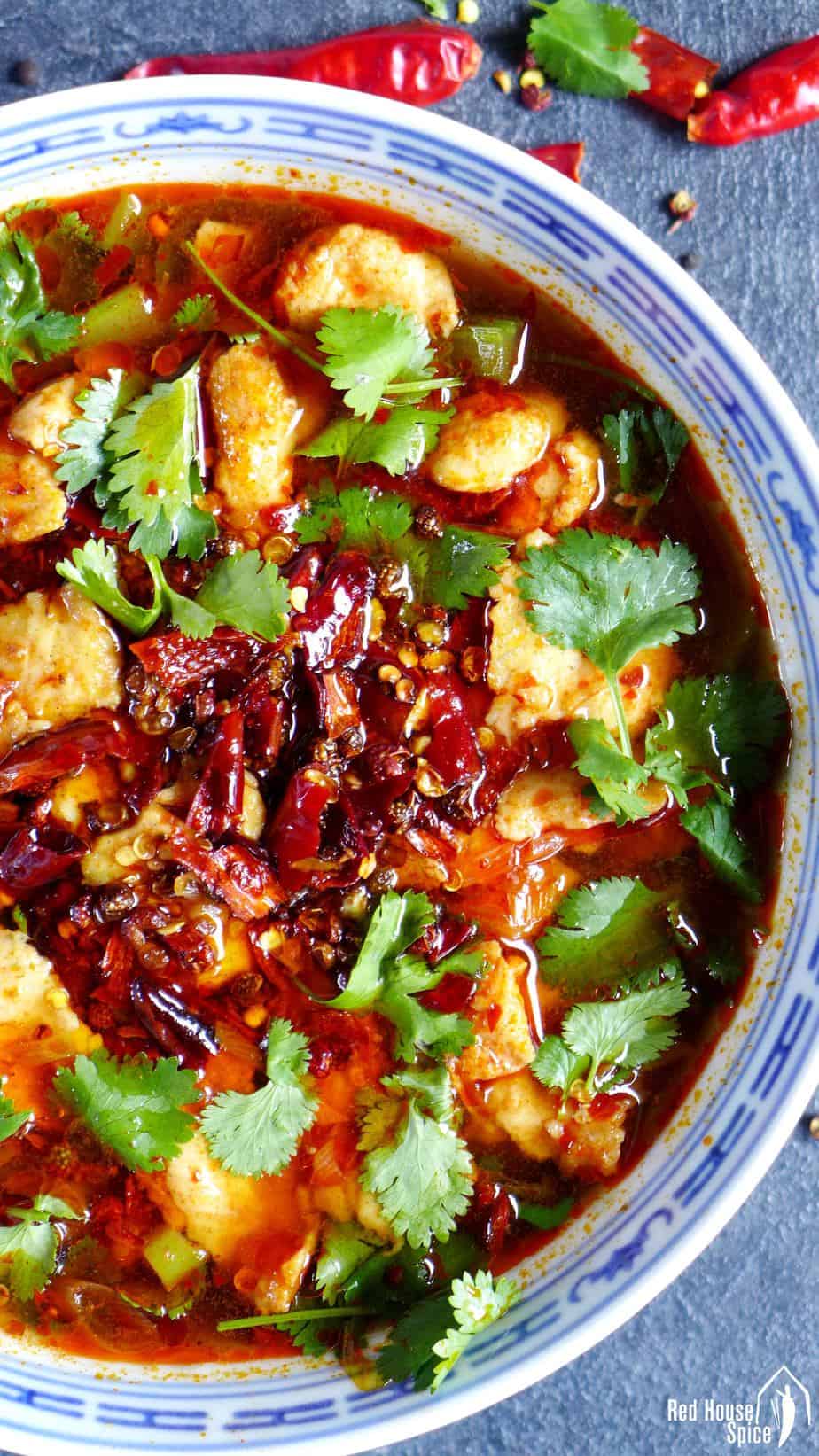
It’s easy to cook!
Many people find it intimidating to cook Sichuan boiled fish at home. I was one of them until I had a try. It’s pretty straight forward. There’s no particular cooking skill involved. As long as you have all the ingredients to hand and follow a detailed, well-written recipe, nothing will go wrong.



When reading the recipe card below, you will notice that I put ingredients in several groups. This corresponds to different cooking steps. Please note that cooking oil is listed in different groups for various purpose. The finished dish doesn’t taste greasy despite the generous use of oil. The oil is essential to draw out the full fragrance of the spices.
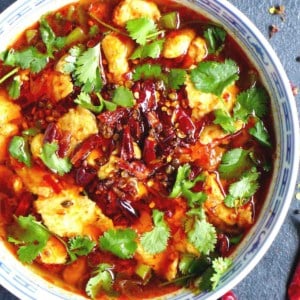
Sichuan boiled fish (Shui Zhu Yu, 水煮鱼)
Ingredients
For the fish
- 250 g skinless, boneless fish fillet - 9oz (see note 1)
- 1 pinch salt
- 1 pinch white pepper
- 1 teaspoon Shaoxing rice wine
- 1 teaspoon corn starch
For the spices
- ½ teaspoon cooking oil
- 15 dried chilli
- 2 teaspoon Sichuan peppercorn - see note 2
For the vegetable
- 1 teaspoon cooking oil
- 250 g celery, cut into thin strips - or bean sprouts
For the broth
- 2 tablespoon cooking oil
- 2 clove garlic - minced
- 1 teaspoon ginger - minced
- 1 stalk scallions - chopped
- 1.5 tablespoon Sichuan chilli bean paste - see note 3
- 1 teaspoon chilli powder
- 400 ml hot water - or chicken stock
For garnishing
- Coriander - chopped
- 2 tablespoon cooking oil
Instructions
Marinate the fish
- Slice the fish fillet diagonally. Marinate with salt, white pepper, rice wine & corn starch.
Fry the spices
- In a wok (or a deep frying pan), fry dried chilli and Sichuan pepper in oil over a low heat until fragrant (do not burn them). Chop coarsely when cooled. Set aside.
Cook the vegetable
- In the same wok, heat up oil over a medium heat, stir in celery. Cook for 1.5 minutes or so (30 seconds if using bean sprouts instead). Transfer to a serving bowl. Set aside.
Make the broth
- Heat up oil in the wok, fry garlic, ginger and spring onion. Add Sichuan chilli bean paste and chilli powder. Pour in water (or chicken stock). Bring it to a full boil.
Cook the fish
- Gently place the fish slices into the wok. When cooked, pour the fish and the soup onto the vegetable.
Garnishing
- Top with fried spices and coriander. Heat up oil then pour over to sizzle the spices. Serve immediately with plain rice.
NOTES
NUTRITION
NUTRITION DISCLOSURE: Nutritional information on this website is provided as a courtesy to readers. It should be considered estimates. Please use your own brand nutritional values or your preferred nutrition calculator to double check against our estimates.



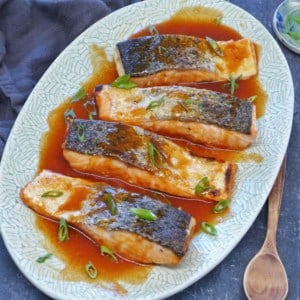
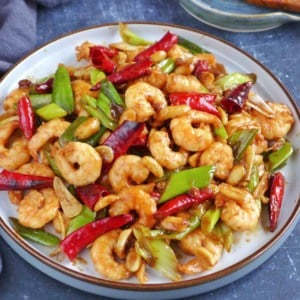
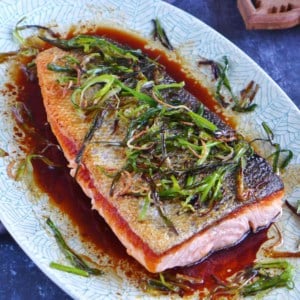
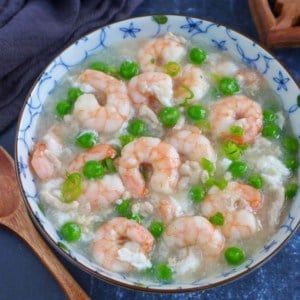
Thanks a lot for this recipe. Te Sichuan fish is in my opinion the Emperor among all of superb Sichuan dishes. Sichuan cuisine rules without any doubt.
You’re welcome Filip! Sichuan food is so addictive, right?
Not sure what went wrong. This turned out very bland. There was some spice; it really wasn’t lack of heat, just lack of flavor. Spices and ginger/garlic had nice smell during sautee, but then those flavors disappeared. Tasted like unseasoned, totally plain fish.
Don’t really understand the “marinade” of the fish. Quantity of materials for that step could not possibly marinate; one side could sit in it, that’s all.
What am I getting wrong?
Sorry to hear that Chris! This dish shouldn’t taste bland at all? Have you used Sichuan chilli bean paste (辣豆瓣酱) which provides the key flavour? Based on your comment, I guess you might have overlooked this ingredient.
I’ve made this recipe a few times now. Should I put the peppers and peppercorns in cheesecloth so that they don’t ruin the dish with pieces/grittiness?
Thank you Karen for trying our my recipe! The authentic version of this dish is supposed to be cooked this way. I don’t think it’s a good idea to wrap dried chillies and Sichuan pepper with cheesecloth as you need to pour hot oil directly over the spices. Unlike many other dishes, you’re not suppose to eat the broth/sauce or spices but only the fish pieces.
Hi. I feel like I missed it somewhere, How long are we supposed to marinate the fish? Thank you.
Hi Mary! You don’t need to count the time. Just follow the sequence suggested in my recipe. Marinate the fish first. It will be ready by the time you need to add it to the broth. Happy cooking!
Thanks for this recipe – it’s super yum! I used basa and bok choy, worked great.
You’re welcome Aaditi! Very happy to know you enjoyed it!
I had been looking for a recipe to use my erjingtiao and tribute peppers along with a jar of doubanjiang that i purchase from on online Chendu supplier. This recipe hit me on so many levels with the crunchiness of the celery, the tenderness of the fish, the savory broth and the tingling spiciness. I really like the way the recipes are presented. it was very easy to follow and I am encouraged to try more. I’m so glad i found you, Wei.
So happy to hear that Annier! Glad that my recipe worked well for you. Happy cooking!
I made this just last night, it was amazing. The only thing I changed was I used soybean sprouts. I was sweating as I ate but couldn’t stop eating it! Thank you for the recipe!
My pleasure Julie! In fact, soybean sprouts are commonly used in this dish in Chinese restaurants. Unfortunately, I don’t have easy access to it.
Hi! Thank you so much for the recipe. Quick question- I have read some recipes that use egg white in the marinade. Do you know why and why do you not use it in yours? Just wondering but either way I can’t wait to try!
Egg white is used to tenderize the fish. If you are using the right type of fish and it’s fresh enough, I don’t think egg white is necessary. Using cornstarch for tenderizing should be enough. Hope this helps.
Wow, your pictures are so beautiful and look appetizing.
Can I use your pictures for my own internal presentation?
I am trying to do some introduction about SiChuan Food.
Thanks Min! I guess you mean using my images for your school/college presentation. If that’s the case, please feel free to do so. It would be nice if you give credit to my blog.
Thanks. Yup, I will put your blog as one of the reference.
Hi! What type of chili powder do you recommend? I’m assuming it’s not the same kind that I put in my taco seasoning….? Thank you! Can’t wait to try making this at home. I love it at my favorite Houston restaurant, Chengdu Taste!
Hi Meredith. I usually use chili powder either from China or India. Please feel free to use any chili powder that’s available to you. If your taco seasoning contains other spices/flavoring other than ground chili, it might not be a good idea to use it in this dish.